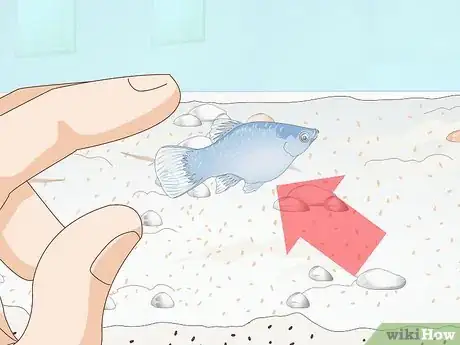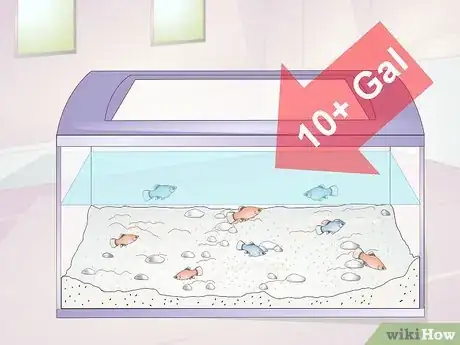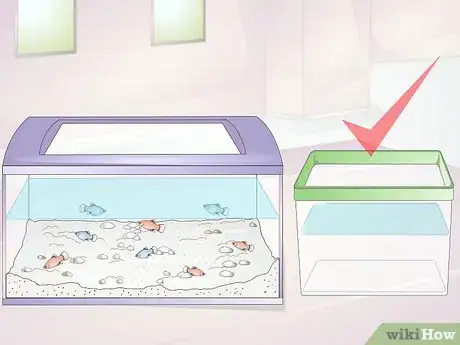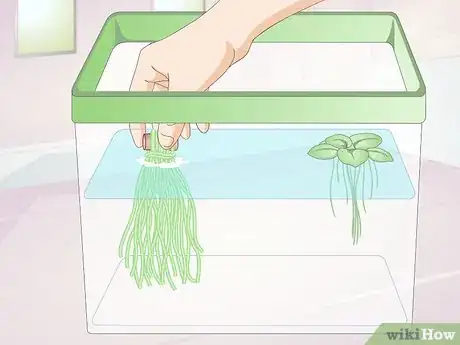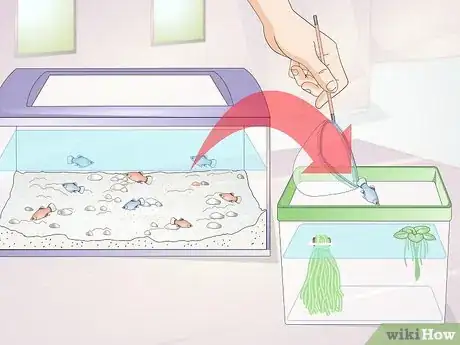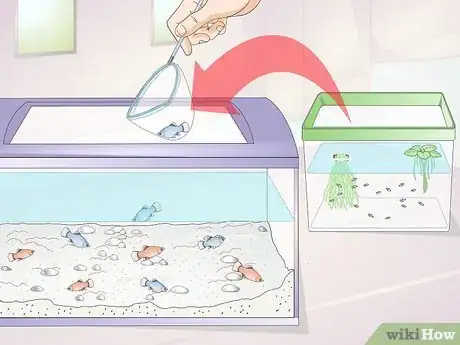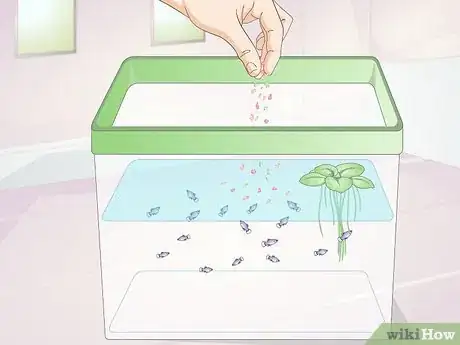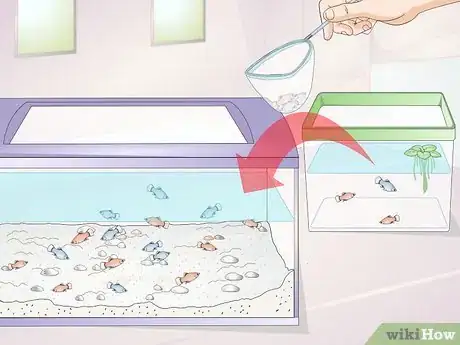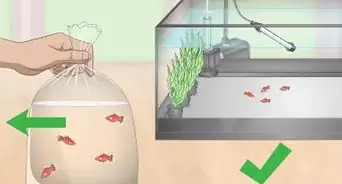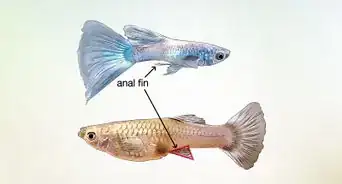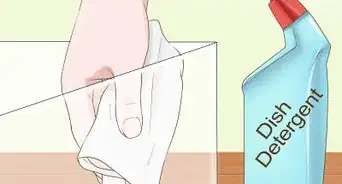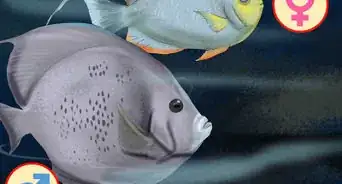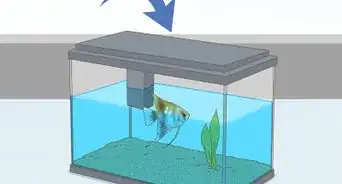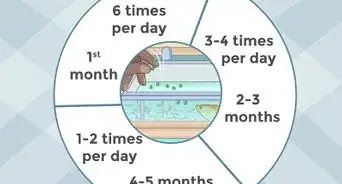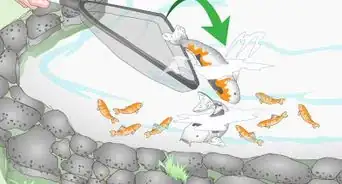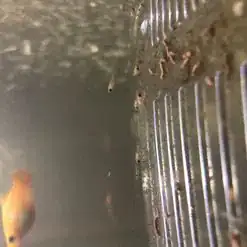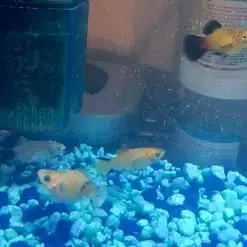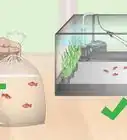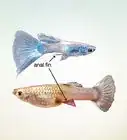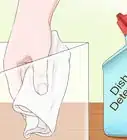This article was co-authored by Craig Morton. Craig Morton is the CEO of Aquarium Doctor Inc. based in Huntington Beach California and servicing Orange County, Los Angeles County, and the Inland Empire. With over 30 years of aquarium experience, Craig specializes in creating custom aquarium designs along with aquarium installation, service, and maintenance.
wikiHow marks an article as reader-approved once it receives enough positive feedback. This article received 13 testimonials and 90% of readers who voted found it helpful, earning it our reader-approved status.
This article has been viewed 314,057 times.
Platy fish (Xiphophorus) are a common variety of fish that come in many different colors and are easy to care for.[1] Platy are a prolific fish, so if you have both males and females, there is a strong possibility you will end up with babies (also known as fry). Platy fry are born more or less fully developed - they hatch from eggs inside their mothers' bodies - so they aren't difficult to care for. However, it is very common for the adult fish to eat the fry, so if you want many of them to survive, here are some actions you'll need to take to ensure this.
Steps
Preparing for Platy Fry
-
1Be on the lookout for pregnant fish. Pregnant platies are easy to spot, so if you keep a close eye on your fish, they shouldn't be a surprise. A pregnant platy will develop a noticeably swollen belly. They can also have an almost rectangular stomach as well when they are close to giving birth.
- It's also common for a pregnant female to develop a dark spot near her back fin. This is caused by the eyes of the unborn fry pressing against her scales.
-
2Ensure your tank is large enough. For a few adult platies, a 10 gallon tank is usually sufficient. However, if you plan for your platies to breed and you want to keep the fry, a much larger tank will be necessary.
- A minimum tank size of 29 gallons is recommended if you plan on letting your fish reproduce not letting them eat their fry.
Advertisement -
3Consider a separate tank. Because platies do eat their young, you will end up with the greatest number of surviving fry if you purchase a separate tank for them to live in while they grow. [2]
- A separate aquarium for your fry can be purchased at most pet stores. This tank should be at least 5 gallons (or more, depending on how many babies the mother produces).
-
4Purchase plants and/or a breeding trap. To survive, whether in a community tank or in a separate tank with only their mother, your fry will need hiding places to escape to. This purpose can be served by either a lot of plants or a breeding trap.[3]
- Plastic plants can be used, but live plants can often be a source of extra nutrition for your fish, who may take small bites of them to supplement their diets.[4]
- There are many types of live plants that platies enjoy, which should be available at your local pet store. Good choices include bunch plants, such as anacharis and cabomba, floating plants like hornwort and water sprite, and mosses such as java moss.[5]
- Many (but probably not all) of your platy fry will survive in a community tank if it contains enough plants for them to hide in.[6]
- A breeding trap is a plastic box with small holes that goes inside a fish tank. The mother is placed inside the breeding trap, and when the fry are born, they can escape through the small holes to avoid being eaten. The mother will not be able to follow them.
-
5Separate the mother from the community tank and wait. If you've opted for a separate tank to keep the fry isolated from the adult fish, separate the mother as soon as you can after you've noticed she's pregnant.[7]
Caring for and Feeding Platy Fry
-
1Return the mother to the community tank. After the mother fish gives birth, you can return her to the community tank (assuming you separated her). The fry will now be free to develop without threat of being eaten.
-
2Feed the fry. Baby platy fish do not require different food from adults. You can feed them the same pellets or flakes that you feed the adults, as well as freeze-dried bloodworms and tubifex, and brine shrimp.[10]
- Feed the fish small amounts several times a day, about as much food as they can eat in three minutes.[11]
- Some platy owners like to crush or grind pelleted or flaked food before feeding it to fry, as this will make it easier for them to eat.[12]
- For platy fish to develop the brilliant colors that make them so beautiful, they must be fed a varied diet early in life, containing both protein and plant-based foods.[13]
- Specially formulated food is commercially available for platy fry, but is not necessary.[14]
-
3Keep their tank clean. Just as with your adult platies, you'll need to keep the tank for the fry clean.
- Changing 25 percent of the water at least every two weeks is typically adequate.[15] If the water becomes cloudy or full of debris, it should be changed more often.
-
4Introduce new fish into the community tank. Once they have grown large enough to fend for themselves, you can move the young fish to the community tank with the older fish.
- Platy reach full size after about four months.[16] If you decide to try to introduce them to the community tank sooner than that, keep an eye on them to make sure they aren't being eaten by the adults.
Expert Q&A
Did you know you can get expert answers for this article?
Unlock expert answers by supporting wikiHow
-
QuestionHow do I keep my fish healthy?
 Craig MortonCraig Morton is the CEO of Aquarium Doctor Inc. based in Huntington Beach California and servicing Orange County, Los Angeles County, and the Inland Empire. With over 30 years of aquarium experience, Craig specializes in creating custom aquarium designs along with aquarium installation, service, and maintenance.
Craig MortonCraig Morton is the CEO of Aquarium Doctor Inc. based in Huntington Beach California and servicing Orange County, Los Angeles County, and the Inland Empire. With over 30 years of aquarium experience, Craig specializes in creating custom aquarium designs along with aquarium installation, service, and maintenance.
Aquarium Specialist, Aquarium Doctor Inc.
-
QuestionWhat is the size of platy fry at the time of birth?
 Community AnswerThey are born about the size of half a grain of rice and are translucent. They will also hide, so they are not easy to spot.
Community AnswerThey are born about the size of half a grain of rice and are translucent. They will also hide, so they are not easy to spot. -
QuestionI think three of my platys look pregnant. How long will it take for them to drop the fry? Also, should I use a fry trap, a nursery tank or an aquarium divider to separate them?
 Community AnswerPlaties are usually pregnant between 6 - 8 weeks. Once you notice that your platy's stomach has a \___/ shape, then you know she is due to give birth soon. Platys tend to stress out when you put them into a breeding trap, so small, separate 10-liter tanks might be better prior to the births.
Community AnswerPlaties are usually pregnant between 6 - 8 weeks. Once you notice that your platy's stomach has a \___/ shape, then you know she is due to give birth soon. Platys tend to stress out when you put them into a breeding trap, so small, separate 10-liter tanks might be better prior to the births.
Warnings
- Don't buy fish if you don't have an aquarium large enough to accommodate them. Platies are very prolific, so a small tank can get over-crowded very quickly.⧼thumbs_response⧽
References
- ↑ http://www.liveaquaria.com/product/prod_display.cfm?c=830+2855+1067&pcatid=1067
- ↑ https://en.aqua-fish.net/articles/guide-keeping-platies-faq-discussion
- ↑ http://animal-world.com/encyclo/fresh/livebearers/platy.php
- ↑ http://pets.thenest.com/baby-platy-like-hide-in-12511.html
- ↑ http://pets.thenest.com/baby-platy-like-hide-in-12511.html
- ↑ http://animal-world.com/encyclo/fresh/livebearers/platy.php
- ↑ https://en.aqua-fish.net/articles/guide-keeping-platies-faq-discussion
- ↑ http://animal-world.com/encyclo/fresh/livebearers/platy.php
- ↑ http://animal-world.com/encyclo/fresh/livebearers/platy.php
- ↑ http://www.liveaquaria.com/product/prod_display.cfm?c=830+2855+1067&pcatid=1067
- ↑ http://animal-world.com/encyclo/fresh/livebearers/platy.php
- ↑ http://www.allabout-aquariumfish.com/2009/03/platy-care-and-breeding.html
- ↑ https://en.aqua-fish.net/articles/guide-keeping-platies-faq-discussion
- ↑ http://www.allabout-aquariumfish.com/2009/03/platy-care-and-breeding.html
- ↑ Craig Morton. Fish & Aquarium Specialist. Expert Interview. 21 July 2020.
- ↑ http://www.allabout-aquariumfish.com/2009/03/platy-care-and-breeding.html
About This Article
If you want to take care of baby platy fish, feed them multiple small meals a day, consisting of fish flakes and dried worms and shrimp. To prevent overfeeding, adjust how much you feed them until they can finish each meal in 3 minutes. In addition, you’ll need to change 25 percent of their water every 2 to 4 weeks, or when the water becomes cloudy. You can combine them with older fish once they are full grown, which takes about 4 months. Read more for tips from our Veterinary reviewer on safely breeding platy fish!
